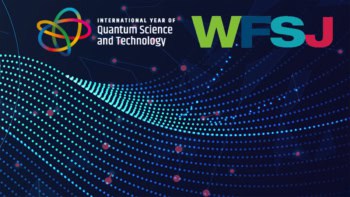By integrating quantum frequency combs into glass chips, researchers have taken an important step towards a scalable quantum computer, explain Michael Kues, Lucia Caspani and Roberto Morandotti

Quantum mechanics offers fundamentally new opportunities for processing information. In contrast to the classical notion of a bit, where the state of a physical system such as a transistor corresponds to either zero or one, a quantum bit (qubit) is in a superposition of zeros and ones. By combining multiple qubits it is possible to form entangled qubit states, in which the unique, non-classical correlations of qubits enable quantum computation.
Manipulating a single qubit changes the whole ensemble and therefore the properties of each entangled qubit, which means that a quantum computer can work in parallel on many computations at once. So, for certain types of problem, a quantum computer can solve tasks exponentially faster than a classical computer, with revolutionary consequences for fields ranging from cryptography and nanotechnology to pharmaceuticals and artificial intelligence.
For certain types of problem, a quantum computer can solve tasks exponentially faster than a classical computer, with revolutionary consequences
Generating multiple entangled qubit states that are both stable and controllable, however, is a massive technological challenge. Systems considered so far have tended to rely on complex and expensive technology to generate quantum superposition among agglomerations of atoms, ions or electrons. But these only work at cryogenic temperatures and have to be extensively shielded from electromagnetic radiation, which limits their scalability and thus their commercial potential.
A more practical qubit candidate is the photon, which interacts less with the surrounding environment and so allows a longer decoherence time, which is the average time after a quantum state is destroyed under normal operating conditions. The other advantage of light is that a perfect framework for sharing photon qubits already exists: the optical fibre network currently used for classical communication. The challenge to enable practical applications is to generate entangled photon states simultaneously in a compact, scalable and cost-effective way.
Towards photonic chips
Ever since Einstein’s explanation of the photoelectric effect more than a century ago, photons have served as powerful quantum laboratories. In the past few decades, optics experiments have revealed the intriguing “non-local” character of entangled photons. It allows phenomena such as quantum teleportation and cryptography, and numerous different entanglement schemes have been investigated and demonstrated. The photon offers several different degrees of freedom that can be successfully entangled, such as polarization, frequency, time, position and orbital angular momentum. Each has advantages and disadvantages depending on the particular application for which it will be used.
While polarization is probably one of the first and most studied degrees of freedom for entanglement, its applications are limited because it is restricted to two perpendicular values, such as horizontal and vertical, and because it is difficult to transport polarization states faithfully through optical fibres. Since scalability is the key to building a quantum computer that can do useful tasks, the ability to generate tens or hundreds of entangled qubits is vital. This could, in principle, be achieved using bulk optical set-ups such as those found in many research laboratories, but it would require hundreds or thousands of optical elements such as mirrors, beamsplitters and phase-shifters – all of which must maintain a certain degree of coherence, therefore hampering this approach.
A promising alternative, which is being investigated by many groups worldwide, is to miniaturize bulk optical set-ups by fabricating them on a photonic chip. Such integrated approaches have only become realistic in recent years thanks to the availability of single splitters and phase shifters at such scales, but it is still not clear how long it will take to reach the fabrication capabilities necessary for building on-chip optical set-ups with the required complexity.
One promising way to remedy this situation is to exploit the frequency domain, where many photons at different wavelengths can be transmitted within the same fibre or waveguide. By combining this with the temporal degree of freedom – whereby information is encoded in the arrival time of single photons (so-called time-bin entangled qubits) – it is possible to generate more interconnected quantum states. This frequency-domain approach is exactly the route currently being investigated by means of quantum frequency combs.
Multiphoton entanglement
Classical frequency combs are ingenious devices that generate a series of equally spaced frequency components, a bit like the teeth of a comb. They can be produced, for example, in the optical regime by mode-locked lasers, where the phase of each spectral component is controlled to generate a train of ultrashort pulses in the temporal domain. The ability to manipulate these structures allows frequency combs to serve as extremely precise optical rulers. These instruments have revolutionized metrology and spectroscopy, and were honoured by the 2005 Nobel Prize for Physics.
Frequency combs are now attracting attention in the quantum regime, where their multifrequency-mode characteristics could create many entangled optical quantum states at once. Initially, these investigations were based on bulky and complex set-ups using nonlinear effects in crystals implemented in optical free-space cavities. But thanks to parametric nonlinear effects – namely spontaneous four-wave mixing (SFWM) – in micro-scale cavities, we can now make classical frequency combs much less complex. An immense research effort over the last 10 years has led, in the past year, to the generation of equidistantly spaced and phase-locked frequency components in a compact, integrated format (Science 351 357).
This advance led our group at the INRS in Canada to combine integrated frequency combs and photon-pair generation in order to generate complex optical quantum states that address the issues of scalability, practicality and compactness for future quantum technology implementations (Science 351 1171). The result is the culmination of a six-year-long effort to combine recent advances in integrated nonlinear optics with quantum optics (Opt. Express 22 6535; Nat. Commun. 6 8236). Specifically, our approach uses a ring waveguide microcavity that exhibits nearly equidistantly spaced resonances (i.e. frequencies that are allowed to oscillate within the cavity), thus defining many accessible frequency channels. Importantly, the device is in an integrated format and can be fabricated using chip-scale semiconductor technologies, thereby allowing it to be incorporated into established electronics platforms.
Powering up the device sets in motion a chain of events that ultimately leads to the generation of entangled states. First, a coupled laser field induces nonlinear frequency conversion, arising from the cavity-enhanced light–matter interaction inside the microring. The resulting nonlinear effect, SFWM, annihilates two photons of the excitation field and generates two new photons on a resonance pair symmetric to the excitation frequency. The microring was designed so that the SFWM process operates over a large bandwidth, leading to several tens of resonance pairs with entangled qubits. Using time-bin entanglement, which encodes quantum information in terms of the relative arrival times of light pulses, a single photon that passes through an interferometer with unbalanced arms will be in a superposition of early and late arrival times, representing the superposition of 0 and 1 for a standard bit. This constitutes a robust single-photon qubit that is compatible with waveguide and fibre network implementations.
Remarkably, the unique multimode structure of the quantum frequency comb readily allows us to combine two entangled photon pairs to generate larger multiphoton qubit states, as required by a useful quantum computer. By selecting four resonances and post-selecting the simultaneous arrival of four photons, we have generated entangled four-photon qubit states within the quantum frequency comb. Furthermore, our results pave the way to a system that can in principle directly generate many qubits. We were able to verify the generation of these entangled states using quantum-interference measurements, which revealed a degree of interference higher than any possible classical implementation.
Outlook
Over the past few years various research groups have been working towards integrating quantum light sources on-chip, while others have been striving to generate complex quantum states in a frequency-comb arrangement based on bulk and elaborate optical set-ups. We have managed, for the first time, to bring together these two very different and seemingly disconnected approaches.
Further improvements of our scheme will let us generate and control multiphoton entangled states, which is a necessary step towards practical quantum computing. This will require us either to properly tailor the pump laser or to introduce quantum gates for manipulating the time-bin qubits on-chip. In addition, while the main photon source (the nonlinear microcavity) is already integrated on-chip, other components, such as the interferometers and filters, are currently fibre-based. To reach practical detection rates, we need to integrate such components directly on-chip, while a complete on-chip source will require hybrid technology to also integrate the laser and the single-photon detectors.
This is an ongoing challenge for the integrated optics community, and different groups around the world are working hard on semiconductor lasers and detectors to reach this goal. Provided that funding is sustained, we predict the first commercial applicability of our scheme in the next 10 years, opening a new era in information processing.



